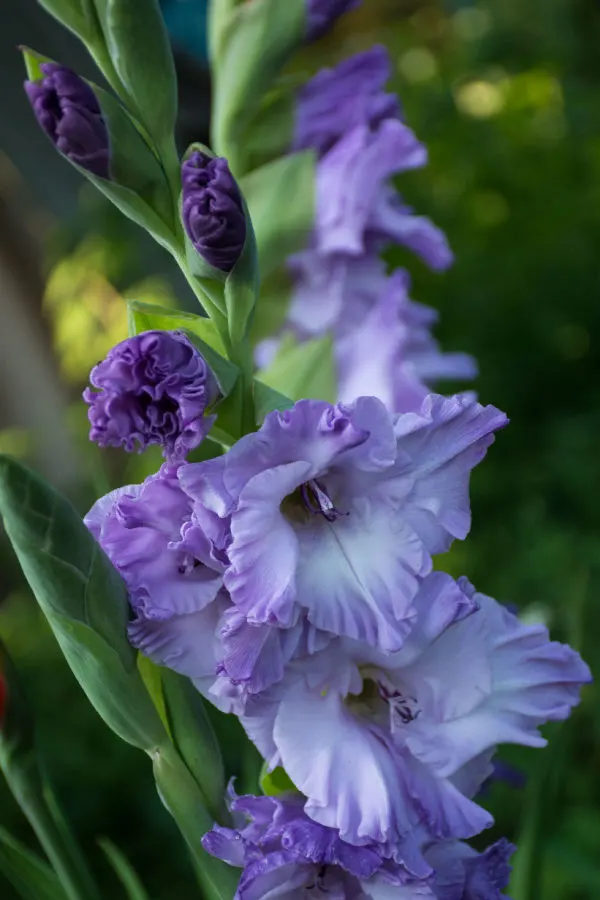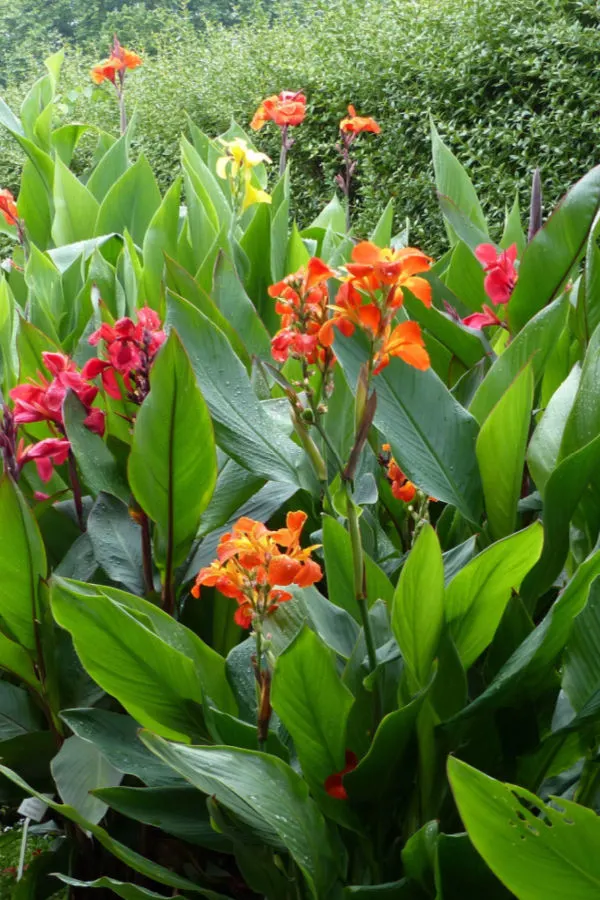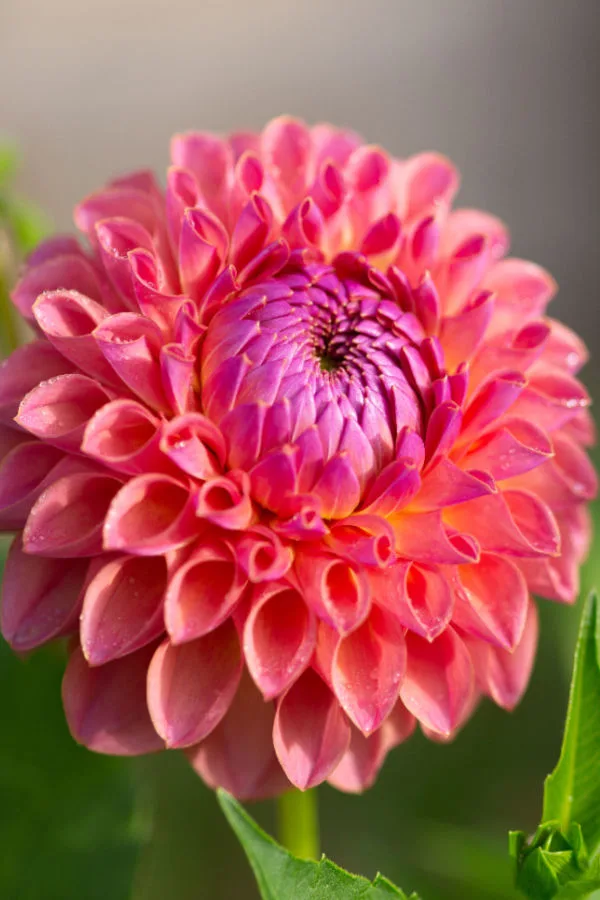Planting bulbs in the spring is one of the best ways to ensure big color and interest in your flowerbeds this summer – and it couldn’t be easier to do!
Although fall is the time when many think of planting popular spring flowering bulbs such as tulips, daffodils and crocus, there are also quite a few bulb varieties that can be planted in the spring for mid to late summer beauty.
Bulbs are so simple to plant. All you need to you need to do is wait for the temperature to warm up a bit, dig your hole and add a little compost and plant the bulb pointy tip up. Then, simply cover up and wait for the magic to happen!

Not only are they low-maintenance, spring planted bulbs also happen to provide some of the biggest, most colorful blooms around. And let’s face it, nothing can bring more oohs and aahs than huge flowers unfurling in your flowerbeds!
In today’s article, we feature three of the most beautiful spring bulbs of all – gladiolus, dahlias and canna lilies. All three have distinct foliage and blooms that can bring a summer landscape alive. We have included planting information along with best practices for each variety, as well as a few affiliate bulb links for some of our favorite selections.
Planting Spring Bulbs – 3 Great Bulbs To Plant In The Spring!
Gladiolus
One of the more well-known of all spring bulbs, gladiolus bloom with brilliance on long spikes that shoot from the ground. From orange, red, pink and purple, to white, yellow and lavender – the range of color choices are astounding.
Gladiolus bulbs are also extremely versatile in the landscape. The are wonderful in mass planting to provide a massive splash of interest. But they also look right at home in small group plantings to accent other perennials.
Many gardeners prize the gladiolus as a cut flower. With their showy blooms on long spikes, they can certainly provide color and height to any flower arrangement.
For best results, plant gladiolus bulbs after the threat of frost has passed. Locate them in an area that will receive full sun. They can tolerate partial shade but the blooms will be less intense. Gladiolus need the sunlight to power deeper hues, and without it, the flowers can pale.

How To Plant Gladiolus – Planting Spring Bulbs
To plant, dig a hole three to six inches deep. The depth of your hole will depend on the size of your bulb – the bigger the bulb, the deeper you will need to plant. Space the bulbs four to six inches part.
Gladiolus need rich, fertile soil to power strong bulb growth and flowering. When planting, add a few inches of compost to the bottom of your hole. Next, sit the bulb down in the compost with the pointy end facing up. Finish filling the hole with a 50/50 mix of compost and soil and water the bulb in.
Once the foliage dies off in late fall, dig up the bulbs. Next, cut the stock back to within a few inches of the bulb. Allow the bulbs to dry out and then store in a warm and dry location to plant again next spring.
- Affiliate Bulb Link: Gladiolus, Bulb (20 Pack) Pastel Mixed
- Affiliate Bulb Link: Gladiolus Carnival Mix Sword Lily
Canna Lilies – Planting Spring Bulbs
Cannas or canna lilies as they are often called are a magnificent perennial that can provide big beauty with both their blooms and their foliage. Although not a lily and not truly a bulbous plant, cannas instead grow from rhizomes that are planted in the spring in much the same method as a bulb.

Depending on the variety, cannas can grow anywhere from two to five or more feet tall. Their large, distinct leaves really add interest to flowerbeds, looking almost like banana leaves as they unfurl. With varieties of foliage that can vary from deep green to red and orange, they pair well when planted around other perennials.
Because they are a rhizome and not a true bulb, canna lilies do not need to go as deep in the soil. To plant safely, wait until the threat of frost has passed and the soil has warmed to at least 60°(F).
Planting Cannas
Dig down to a depth of four to six inches in the soil. Next, add back in a few inches of soil mixed evenly with compost. This will help provide plenty of loose soil for the roots to expand. Next, place the root down into the compost so that it sits a few inches below the soil line.
When planting, plant with the eyes of the rhizome facing up. Finish by covering with a 50/50 mix of soil and compost. Cannas grow big, so allow at least 18 inches between each rhizome when planting.

Always plant cannas so they can get maximum sunlight. When growing in partial shade or low light, both the foliage and blooms will be less bright. Most cannas will require support to handle their tall growth. Once they begin flowering, remove spent blooms to help the plant continue flowering.
The good news with cannas is that they do not need to be dug up for the winter unless you live in growing zones 6 or below. They are fairly hardy and can handle growing in climates with moderately cold winters.
- Affiliate Bulb Link : Cannas – Musifolia
- Affiliate Bulb Link: Mixed Tall Canna Lily Value Bag – 6 Bulbs/pkg
Dahlias – Planting Spring Bulbs
The massive blooms of dahlias can instantly become the centerpiece of any flowerbed! Dahlias are another plant that act and grow like bulbs but are actually tubers. They are extremely low maintenance during the growing season and their flowers can be nothing short of spectacular.
Dahlias are in the same family as annual sunflowers and zinnias, but their blooms can be big and quite colorful. In fact, one variety is so large it carries the name dinner plate! See: Growing Dahlias – How To Add Stunning Summer Blooms With Massive Color!

Dahlias do best when planted in rich, fertile soil. Much as with the other two spring planted varieties, begin by amending the soil with plenty of compost at planting time. To keep the tubers safe, wait until the threat of frost has passed before planting.
Planting Dahlias
Begin by digging your planting hole to a depth of five to six inches. Next, add back in a few inches of compost to the bottom of the hole. Place your dahlia tubers in the bottom of the planting hole with the tips or eyes facing up.
Once in the hole, fill the remainder with a 50/50 mix of soil and compost. Finish by watering the bulb into the soil. Locate your dahlias where they can receive as much sun as possible. After plants finish blooming and die back in the fall, the tubers can be dug up in the fall and over-wintered in a cool, dark spot for re-planting each year.
Here is to planting a few spring bulbs this year and bringing big summer color to your landscape this year. With just a little work this spring, you can have lasting interest in your flowerbeds all season long!
Follow Our Facebook Page For Great Gardening Tips And Advice! This Is My Garden Facebook Page
This Is My Garden is a garden website created by gardeners, for gardeners. Jim and Mary Competti have been writing gardening, DIY and recipe articles and books and speaking for over 15 years from their 46 acre Ohio farm. They publish three articles every week, 52 weeks a year. Sign up today to follow via email, or follow along!

